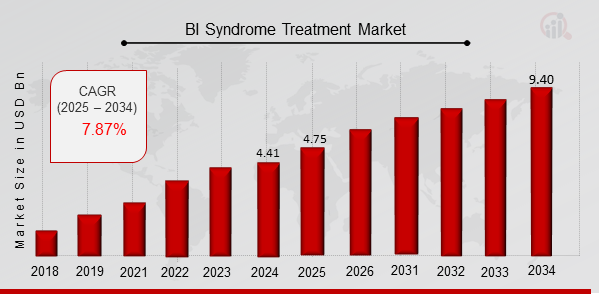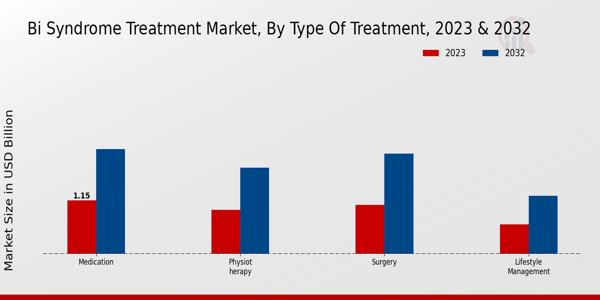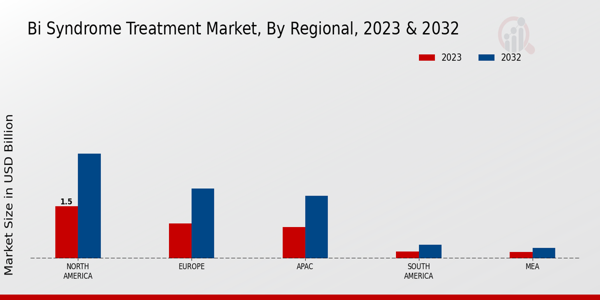BI Syndrome Treatment Market Overview
As per MRFR analysis, the BI Syndrome Treatment Market Size was estimated at 4.41 (USD Billion) in 2024. The BI Syndrome Treatment Market Industry is expected to grow from 4.75 (USD Billion) in 2025 to 9.40 (USD Billion) till 2034, at a CAGR (growth rate) is expected to be around 7.87% during the forecast period (2025 - 2034).
Key BI Syndrome Treatment Market Trends Highlighted
The BI Syndrome Treatment Market is influenced by several key market drivers. The increasing prevalence of BI syndrome is a significant factor pushing the demand for effective treatment options. Rising awareness among healthcare providers and patients about the condition contributes to this growth. Additionally, advancements in research and development are leading to more innovative therapies, enhancing treatment efficacy and outcomes for patients. Increased funding for biomedical research has also improved the understanding of BI syndrome, which encourages the development of new treatment modalities. There are numerous opportunities to be explored in the market.Expansion into emerging economies presents a chance for companies to diversify their market presence and provide treatment options to underserved populations. Collaborations between pharmaceutical companies and academic institutions can facilitate the discovery of novel therapies. Furthermore, the integration of technology in treatment delivery, such as telemedicine and digital health, can enhance patient access and adherence to treatment. The ongoing trend toward personalized medicine is also reshaping how treatments are developed, ensuring they are tailored to individual patient's genetic profiles and health conditions. Trends in recent times show a growing emphasis on holistic treatment approaches that consider the overall well-being of patients.There is an increasing interest in combining traditional methods with complementary therapies to achieve better patient outcomes. The market is witnessing a shift towards more patient-centered care, where treatment plans are individualized based on patient preferences and lifestyle. Additionally, the role of data analytics in monitoring treatment effectiveness is becoming more prominent, allowing for real-time adjustments to therapy as needed. Overall, the market is evolving to meet the needs of patients while advancing in clinical and technological aspects.

Source: Primary Research, Secondary Research, MRFR Database and Analyst Review
BI Syndrome Treatment Market Drivers
Increasing Prevalence of BI Syndrome
One of the foremost drivers for the BI Syndrome Treatment Market Industry is the increasing prevalence of BI Syndrome across various demographics. As awareness of this syndrome grows among both the general public and healthcare practitioners, more individuals are being diagnosed and seeking treatment. The rising incidence rates can be attributed to several factors, including lifestyle changes, stress levels, and greater diagnostic capabilities.A more informed society is also recognizing symptoms earlier, leading to timely medical intervention. Consequently, this surge in patient numbers directly fuels the demand for effective treatment options in the market. With forecasts indicating strong growth, the industry is positioned to innovate and expand its offerings. Increased research funding in understanding BI Syndrome has led to the development of more tailored therapeutics and interventions.Additionally, as healthcare systems worldwide evolve to meet the needs of patients suffering from chronic conditions, there is a stronger focus on specialized care solutions. This focus not only aids in the diagnosis and treatment of existing cases but also caters to preventive measures, further expanding the market reach. As healthcare providers become more equipped to manage this syndrome, their insights will contribute to refining treatment approaches, thereby enhancing patient outcomes.Overall, the heightened prevalence of BI Syndrome serves as a critical driver within the BI Syndrome Treatment Market, prompting stakeholders to invest in research and product development to meet the rising demand.
Advancements in Medical Technology
The BI Syndrome Treatment Market Industry is significantly driven by advancements in medical technology. Innovations in diagnostics, therapeutics, and treatment protocols have enhanced the ability to effectively address BI Syndrome. New technologies, such as telemedicine, provide better access to specialists and improved patient monitoring capabilities. These developments have led to more personalized treatment plans, which increase efficacy and can reduce recovery times.As the industry embraces these advancements, companies are better equipped to meet the varied needs of patients.
Growing Government and Private Investments
Another pivotal driver for the BI Syndrome Treatment Market Industry is the growth in government and private investments in healthcare. Increased funding is dedicated towards research and development of more effective treatment protocols, which boosts the overall market landscape. Governments globally are also starting initiatives that promote awareness and education about BI Syndrome, which leads to higher diagnosis rates and subsequently escalates the demand for treatment solutions.
BI Syndrome Treatment Market Segment Insights:
BI Syndrome Treatment Market Type of Treatment Insights
The BI Syndrome Treatment Market revenue has been significantly shaped by various types of treatment, with each category contributing uniquely to the overall market dynamics. In 2023, the market is valued at 3.79 USD Billion and is projected to grow to 7.5 USD Billion by 2032, demonstrating robust demand for effective treatment options. The market segmentation based on the type of treatment includes Medication, Physiotherapy, Surgery, and Lifestyle Management, each with its own growth trajectory and importance. Among these, Medication holds a major position, with a valuation of 1.15 USD Billion in 2023 and expected growth to 2.25 USD Billion in 2032, primarily due to the increasing reliance on pharmaceutical solutions and advancements in drug formulations.Physiotherapy, valued at 0.95 USD Billion in 2023 and projected at 1.85 USD Billion by 2032, plays an essential role as it supports recovery through physical rehabilitation and has witnessed an uptick in popularity as a non-invasive solution. Surgery is also a significant player in this market; with a valuation of 1.05 USD Billion in 2023, reaching 2.15 USD Billion in 2032, it represents an essential intervention for patients requiring more immediate or invasive care, thus demonstrating a critical aspect of BI Syndrome management. Lastly, Lifestyle Management, although valued at 0.64 USD Billion in 2023 and forecasted to grow to 1.25 USD Billion by 2032, holds importance in maintaining patient wellbeing.The market trends suggest a growing shift towards holistic and preventive approaches, which enhance the relevance of Lifestyle Management. With an expected CAGR of 7.87 from 2024 to 2032, the BI Syndrome Treatment Market industry is poised for significant growth, driven by increasing patient awareness, technological advancements, and the rising prevalence of BI syndrome. These segments reflect a comprehensive landscape, emphasizing the diverse array of treatment options available, addressing a spectrum of patient needs, and marking a critical period of evolution in BI Syndrome management.The market data underlines a trend toward integrated care approaches, whereby each treatment type is not isolated but rather part of a broader strategy to improve patient outcomes and quality of life.

Source: Primary Research, Secondary Research, MRFR Database and Analyst Review
BI Syndrome Treatment Market Patient Age Group Insights
The BI Syndrome Treatment Market has shown significant growth within the Patient Age Group, which is classified mainly into Pediatric, Adult, and Geriatric categories. In 2023, the overall market is valued at 3.79 USD Billion and is expected to reach larger figures by 2032, reflecting the rising demand for effective treatments across different age groups. Pediatric patients increasingly dominate this market segment due to the growing awareness of diagnosing BI syndrome at a younger age, leading to better management and outcomes. Meanwhile, the Adult segment represents a substantial portion of the BI Syndrome Treatment Market revenue as this demographic experiences a rise in lifestyle-related health complications linked to BI syndrome.The Geriatric age group also plays a vital role; as this segment typically has more complex health conditions, the need for tailored treatment options is continuously called for. Overall, the market growth is driven by increasing healthcare expenditures, advancements in treatment options, and heightened awareness of BI syndrome, although challenges such as high treatment costs and the need for extensive research remain present across all age demographics. The BI Syndrome Treatment Market statistics reflect a dynamic evolution with opportunities for innovative solutions to cater to each age group's unique needs.
BI Syndrome Treatment Market Route of Administration Insights
The BI Syndrome Treatment Market, focusing on the Route of Administration, is poised for notable growth, emphasizing the increasing utilization of various administration methods. In 2023, the market is valued at 3.79 billion USD, with a strong trajectory forecasted as treatment methodologies evolve. Oral administration holds a significant share due to its convenience and patient compliance, making it a preferred choice in numerous therapeutic scenarios. Injectable routes also play a crucial role, often favored for their rapid absorption and efficacy, while topical treatments cater to localized conditions, offering targeted relief.The combination of these methods reflects a diverse approach within the market, addressing distinct patient needs and preferences. Rising awareness of BI syndrome, coupled with advancements in drug delivery technologies, is driving market growth, while challenges such as the formulation stability and cost-effectiveness of treatments persist. Overall, the BI Syndrome Treatment Market segmentation highlights the importance of tailored treatment strategies in enhancing patient outcomes and underscores ongoing opportunities for innovation within this space.
BI Syndrome Treatment Market Severity of Condition Insights
The BI Syndrome Treatment Market reflects a comprehensive landscape defined by the severity of the condition, which plays a pivotal role in market dynamics. The market achieved a valuation of 3.79 billion USD in 2023, exhibiting robust growth potential as it is projected to reach 7.5 billion USD by 2032. Within this framework, the classification according to severity reveals critical insights; the mild cases often represent a significant portion of the market, driving accessibility and early intervention strategies. Conversely, moderate and severe categories hold substantial importance due to their relation to more complex treatment needs and higher healthcare costs, which can influence overall market growth.The moderate segment, while substantial, highlights the need for tailored therapeutic approaches, thereby fostering innovation in treatment solutions. Severe cases consistently demand urgent and specialized care, representing opportunities for pharmaceutical advancements and targeted therapies. As stakeholders navigate the BI Syndrome Treatment Market statistics, understanding the nuances of severity will be essential in developing effective market strategies and addressing the varying levels of treatment requirements effectively.
BI Syndrome Treatment Market Regional Insights
The BI Syndrome Treatment Market is projected to be valued at 3.79 USD Billion in 2023, reflecting steady demand for treatment options across various regions. North America holds a majority share, with a valuation of 1.5 USD Billion in 2023, and is expected to reach 3.0 USD Billion by 2032, emphasizing its dominance in the industry. Europe follows, representing a significant market, valued at 1.0 USD Billion in 2023 and expected to grow to 2.0 USD Billion by 2032, driven by increasing awareness and healthcare advancements. The APAC region, while smaller, features growth potential, beginning at 0.9 USD Billion in 2023 and reaching 1.8 USD Billion by 2032, showcasing emerging markets supporting the need for efficient BI syndrome treatments.In South America, the market is valued at 0.2 USD Billion this year, with expectations to double by 2032 to 0.4 USD Billion, reflecting a growing focus on healthcare improvements. Lastly, the MEA region stands at 0.19 USD Billion in 2023 and is anticipated to grow to 0.3 USD Billion, illustrating gradual market development. The variations among these regions demonstrate diverse healthcare challenges and opportunities within the BI Syndrome Treatment Market revenue, showcasing the potential for specialized treatment approaches tailored to regional needs.

Source: Primary Research, Secondary Research, MRFR Database and Analyst Review
BI Syndrome Treatment Market Key Players and Competitive Insights:
The BI Syndrome Treatment Market is characterized by a competitive landscape that is continuously evolving, driven by advancements in medical technology, increasing awareness about the condition, and a growing demand for effective treatment options. Companies operating in this market are focused on developing innovative therapies and expanding their product portfolios to meet the unique needs of patients suffering from BI syndrome. These competitive dynamics foster an environment where collaboration, research and development, and strategic partnerships are essential for companies aiming to strengthen their market position. The landscape is marked by various players, each seeking to leverage their strengths and capabilities to capture a larger market share while also addressing regulatory challenges and ensuring the utmost safety and efficacy of their products.Johnson and Johnson has established a formidable presence in the BI Syndrome Treatment Market, utilizing a strong research and development pipeline that promotes the creation of targeted therapies for better patient outcomes. The company's extensive experience in the pharmaceutical sector allows it to understand the complexities associated with BI syndrome and tailor solutions that meet the specific demands of healthcare professionals and patients alike. Johnson and Johnson benefits from a robust distribution network bolstered by its global reach, enabling the company to effectively market its offerings across diverse regions. Additionally, its commitment to innovation is reflected in the continuous improvement of treatment procedures and the introduction of new medication formulations, which position it favorably against competitors in this fast-paced market.Gilead Sciences has carved out a notable identity within the BI Syndrome Treatment Market, distinguished by its dedication to research and development focused on addressing unmet medical needs. The company's portfolio includes advanced therapeutic options that are often at the forefront of BI syndrome treatment, showcasing its commitment to developing solutions that enhance patient's quality of life. Gilead Sciences emphasizes strategic alliances and partnerships to leverage external expertise and resources, enhancing its capabilities to deliver effective therapies. By focusing on precision medicine, Gilead develops targeted treatments that demonstrate efficacy while minimizing side effects, giving it a competitive edge. Moreover, the company's ongoing investment in clinical trials and studies reinforces its position as a leader in the BI syndrome treatment space, allowing it to respond effectively to emerging trends and regulatory requirements.
Key Companies in the BI Syndrome Treatment Market Include:
- Johnson and Johnson
- Gilead Sciences
- Eli Lilly
- Teva Pharmaceutical Industries
- Roche
- AbbVie
- Pfizer
- Novartis
- Bayer
- GlaxoSmithKline
- Amgen
- Bristol-Myers Squibb
- Merck and Co
- Sanofi
- AstraZeneca
BI Syndrome Treatment Market Industry Developments
Recent developments in the BI Syndrome Treatment Market highlight a surge in innovative therapies and treatment options to address this complex condition. Companies like Johnson & Johnson and Gilead Sciences are advancing research that shows promise in improving patient outcomes through novel biologic therapies. Eli Lilly and Roche are currently engaged in clinical trials focusing on personalized treatments that aim to more effectively target disease mechanisms. The market is witnessing heightened collaboration amongst these industry leaders, notably with Pfizer and Novartis strengthening their portfolios through ongoing partnerships. Recent mergers and acquisitions have occurred, with Teva Pharmaceutical Industries acquiring smaller biotech firms to enhance its research capabilities in BI Syndrome. In the realm of market valuation, several companies, such as AbbVie and Amgen, have experienced significant growth as a result of robust developments in their therapeutic offerings. This increase in valuation is further bolstered by the rising demand for effective treatments, contributing to a competitive landscape among the key players. Current affairs reveal sustained investment trends aimed at expanding the technologies and methodologies that govern the treatment landscape of BI Syndrome, aiding in the overall progress of patient care.
BI Syndrome Treatment Market Segmentation Insights
- BI Syndrome Treatment Market Type of Treatment Outlook
- Medication
- Physiotherapy
- Surgery
- Lifestyle Management
- BI Syndrome Treatment Market Patient Age Group Outlook
- Pediatric
- Adult
- Geriatric
- BI Syndrome Treatment Market Route of Administration Outlook
- BI Syndrome Treatment Market Severity of Condition Outlook
| Report Attribute/Metric |
Details |
|
Market Size 2024
|
4.41 (USD Billion)
|
|
Market Size 2025
|
4.75 (USD Billion)
|
|
Market Size 2034
|
9.40 (USD Billion)
|
|
Compound Annual Growth Rate (CAGR)
|
7.87 % (2025 - 2034)
|
|
Report Coverage
|
Revenue Forecast, Competitive Landscape, Growth Factors, and Trends
|
|
Base Year
|
2024
|
|
Market Forecast Period
|
2025 - 2034
|
|
Historical Data
|
2020 - 2024
|
| Market Forecast Units |
USD Billion |
| Key Companies Profiled |
Johnson and Johnson, Gilead Sciences, Eli Lilly, Teva Pharmaceutical Industries, Roche, AbbVie, Pfizer, Novartis, Bayer, GlaxoSmithKline, Amgen, Bristol-Myers Squibb, Merck and Co, Sanofi, AstraZeneca |
| Segments Covered |
Type of Treatment, Patient Age Group, Route of Administration, Severity of Condition, Regional |
| Key Market Opportunities |
Increasing prevalence of BI syndrome, Advancements in diagnostic methods, Development of targeted therapies, Rising healthcare expenditure, Expansion of telehealth services |
| Key Market Dynamics |
Increasing prevalence of BI syndrome, Advancements in treatment options, Growing awareness and diagnosis, Rising investment in healthcare, Expanding patient support networks |
| Countries Covered |
North America, Europe, APAC, South America, MEA |
Frequently Asked Questions (FAQ) :
The BI Syndrome Treatment Market is projected to be valued at 9.4 USD Billion by 2034.
The expected CAGR for the BI Syndrome Treatment Market from 2025 to 2034 is 7.87%.
North America holds the largest market share in the BI Syndrome Treatment Market with a valuation of 1.5 USD Billion in 2023.
The Medication segment is expected to reach a market value of 2.25 USD Billion by 2032.
What is the anticipated market size for the Physiotherapy segment by 2032?
Key players in the BI Syndrome Treatment Market include Johnson and Johnson, Gilead Sciences, Eli Lilly, and Pfizer.
The Surgery segment is expected to be valued at 2.15 USD Billion by 2032.
The Lifestyle Management segment is expected to grow to a market value of 1.25 USD Billion by 2032.
The Asia-Pacific region is forecasted to reach a market value of 1.8 USD Billion by 2032.
Current trends and challenges influencing the market include advancements in treatment methods and increasing awareness among patients.

















